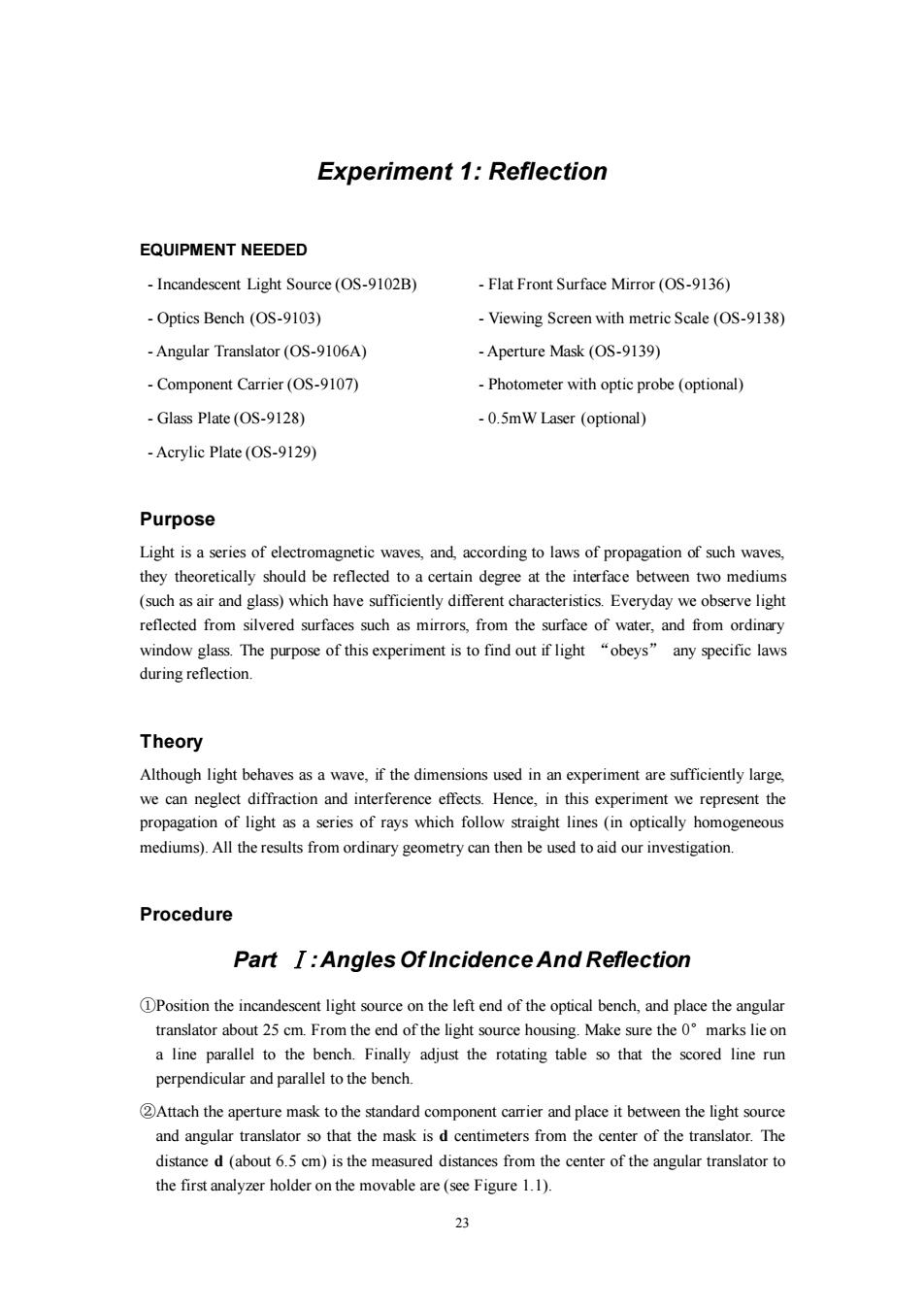正在加载图片...

Experiment 1:Reflection EQUIPMENT NEEDED Incandescent Light Source(OS-9102B) Flat Front Surface Mirror(OS-9136) -Optics Bench(OS-9103) Viewing Screen with metric Scale(OS-9138) Angular Translator(OS-9106A) Aperture Mask(OS-9139) -Component Carrier(OS-9107) -Photometer with optic probe(optional) Glass Plate(OS-9128) -0.5mW Laser (optional) -Acrylic Plate(OS-9129) Purpose Light is a series of electromagnetic waves,and,according to laws of propagation of such waves, they theoretically should be reflected to a certain degree at the interface between two mediums (such as air and glass)which have sufficiently different characteristics.Everyday we observe light reflected from silvered surfaces such as mirrors,from the surface of water,and from ordinary window glass.The purpose of this experiment is to find out if light "obeys"any specific laws during reflection. Theory Although light behaves as a wave,if the dimensions used in an experiment are sufficiently large, we can neglect diffraction and interference effects.Hence,in this experiment we represent the propagation of light as a series of rays which follow straight lines(in optically homogeneous mediums).All the results from ordinary geometry can then be used to aid our investigation. Procedure Part I:Angles OfIncidence And Reflection DPosition the incandescent light source on the left end of the optical bench,and place the angular translator about 25 cm.From the end of the light source housing.Make sure the 0 marks lie on a line parallel to the bench.Finally adjust the rotating table so that the scored line run perpendicular and parallel to the bench. 2Attach the aperture mask to the standard component carrier and place it between the light source and angular translator so that the mask is d centimeters from the center of the translator.The distance d (about 6.5 cm)is the measured distances from the center of the angular translator to the first analyzer holder on the movable are(see Figure 1.1). 2323 Experiment 1: Reflection EQUIPMENT NEEDED - Incandescent Light Source (OS-9102B) - Optics Bench (OS-9103) - Angular Translator (OS-9106A) - Component Carrier (OS-9107) - Glass Plate (OS-9128) - Acrylic Plate (OS-9129) - Flat Front Surface Mirror (OS-9136) - Viewing Screen with metric Scale (OS-9138) - Aperture Mask (OS-9139) - Photometer with optic probe (optional) - 0.5mW Laser (optional) Purpose Light is a series of electromagnetic waves, and, according to laws of propagation of such waves, they theoretically should be reflected to a certain degree at the interface between two mediums (such as air and glass) which have sufficiently different characteristics. Everyday we observe light reflected from silvered surfaces such as mirrors, from the surface of water, and from ordinary window glass. The purpose of this experiment is to find out if light “obeys” any specific laws during reflection. Theory Although light behaves as a wave, if the dimensions used in an experiment are sufficiently large, we can neglect diffraction and interference effects. Hence, in this experiment we represent the propagation of light as a series of rays which follow straight lines (in optically homogeneous mediums). All the results from ordinary geometry can then be used to aid our investigation. Procedure Part Ⅰ: Angles Of Incidence And Reflection ①Position the incandescent light source on the left end of the optical bench, and place the angular translator about 25 cm. From the end of the light source housing. Make sure the 0°marks lie on a line parallel to the bench. Finally adjust the rotating table so that the scored line run perpendicular and parallel to the bench. ②Attach the aperture mask to the standard component carrier and place it between the light source and angular translator so that the mask is d centimeters from the center of the translator. The distance d (about 6.5 cm) is the measured distances from the center of the angular translator to the first analyzer holder on the movable are (see Figure 1.1)